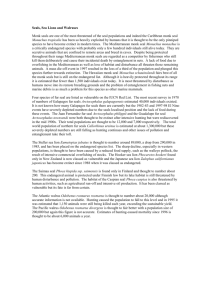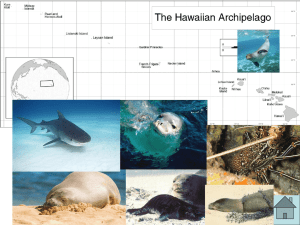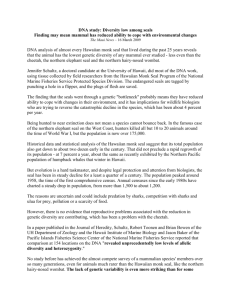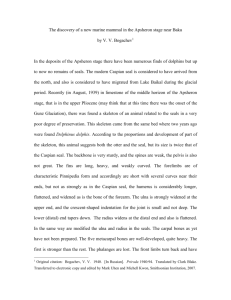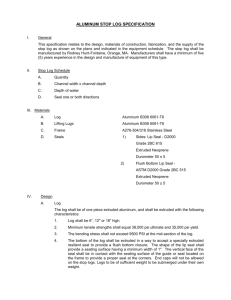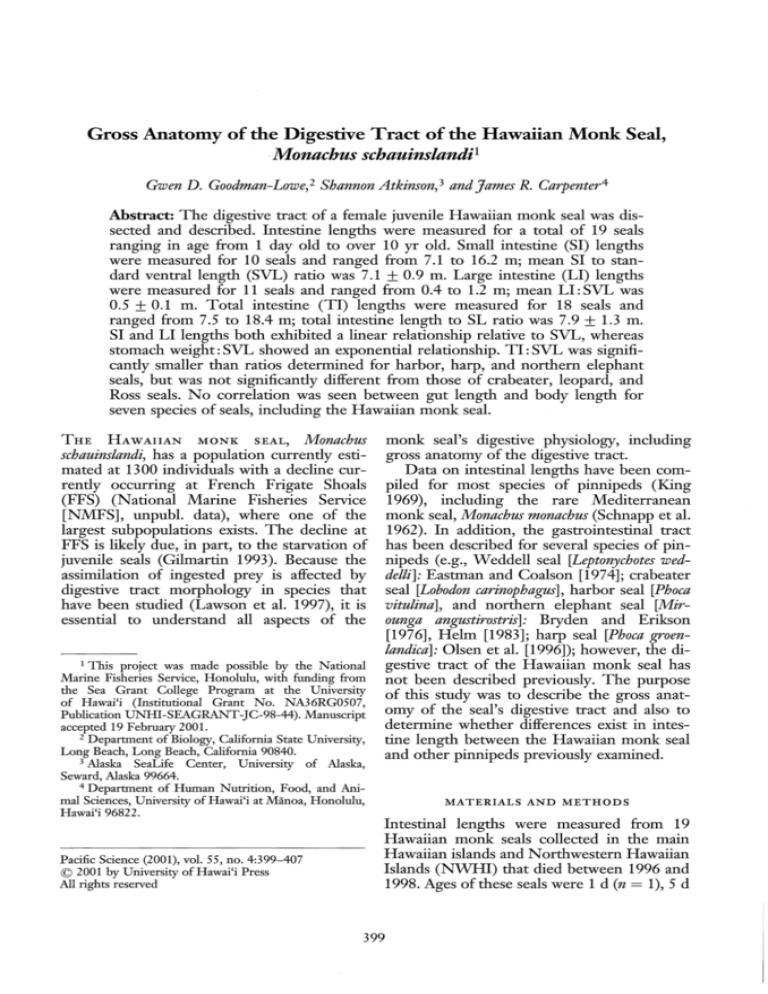
Gross Anatomy of the Digestive Tract of the Hawaiian Monk Seal,
Monachus schauinslandi 1
Gwen D. Goodman-Lowe, 2 Shannon Atkinson, 3 and James R. Carpenter 4
Abstract: The digestive tract of a female juvenile Hawaiian monk seal was dissected and described. Intestine lengths were measured for a total of 19 seals
ranging in age from 1 day old to over 10 yr old. Small intestine (SI) lengths
were measured for 10 seals and ranged from 7.1 to 16.2 m; mean SI to standard ventral length (SVL) ratio was 7.1 ± 0.9 m. Large intestine (LI) lengths
were measured for 11 seals and ranged from 0.4 to 1.2 m; mean LI: SVL was
0.5 ± 0.1 m. Total intestine (TI) lengths were measured for 18 seals and
ranged from 7.5 to 18.4 m; total intestine length to SL ratio was 7.9 ± 1.3 m.
SI and LI lengths both exhibited a linear relationship relative to SVL, whereas
stomach weight: SVL showed an exponential relationship. TI: SVL was significantly smaller than ratios determined for harbor, harp, and northern elephant
seals, but was not significantly different from those of crabeater, leopard, and
Ross seals. No correlation was seen between gut length and body length for
seven species of seals, including the Hawaiian monk seal.
THE HAWAIIAN MONK SEAL, Monachus
schauinslandi, has a population currently estimated at 1300 individuals with a decline currently occurring at French Frigate Shoals
(FFS) (National Marine Fisheries Service
[NMFS], unpubl. data), where one of the
largest subpopulations exists. The decline at
FFS is likely due, in part, to the starvation of
juvenile seals (Gilmartin 1993). Because the
assimilation of ingested prey is affected by
digestive tract morphology in species that
have been studied (Lawson et al. 1997), it is
essential to understand all aspects of the
1 This project was made possible by the National
Marine Fisheries Service, Honolulu, with funding from
the Sea Grant College Program at the University
of Hawai'i (Institutional Grant No. NA36RG0507,
Publication UNHl-SEAGRANT-JC-98-44). Manuscript
accepted 19 February 2001.
2 Department of Biology, California State University,
Long Beach, Long Beach, California 90840.
3 Alaska SeaLife Center, University of Alaska,
Seward, Alaska 99664.
4 Department of Human Nutrition, Food, and Animal Sciences, University of Hawai'i at Manoa, Honolulu,
Hawai'i 96822.
Pacific Science (2001), vol. 55, no. 4:399-407
© 2001 by University of Hawai'i Press
All rights reserved
monk seal's digestive physiology, including
gross anatomy of the digestive tract.
Data on intestinal lengths have been compiled for most species of pinnipeds (King
1969), including the rare Mediterranean
monk seal, Monachus monachus (Schnapp et al.
1962). In addition, the gastrointestinal tract
has been described for several species of pinnipeds (e.g., Weddell seal [Leptonychotes weddel/i]: Eastman and Coalson [1974]; crabeater
seal [Lobodon carinophag;us], harbor seal [Phoca
vitulina], and northern elephant seal [Mirounga angustirostris]: Bryden and Erikson
[1976], Helm [1983]; harp seal [Phoca groenlandica]: Olsen et al. [1996]); however, the digestive tract of the Hawaiian monk seal has
not been described previously. The purpose
of this study was to describe the gross anatomy of the seal's digestive tract and also to
determine whether differences exist in intestine length between the Hawaiian monk seal
and other pinnipeds previously examined.
MATERIALS AND METHODS
Intestinal lengths were measured from 19
Hawaiian monk seals collected in the main
Hawaiian islands and Northwestern Hawaiian
Islands (NWHI) that died between 1996 and
1998. Ages of these seals were 1 d (n = 1), 5 d
399
PACIFIC SCIENCE· October 2001
400
= 1),9 d (n = 1), <1 yr (n = 9),J2 (n = 1),
adult (n = 2), > 10 yr (n = 1); J2 seals are approximately 2 yr old and adults are approximately > 5 yr old. For seals less than 5-6
weeks old (age at weaning), the exact birth
date was known. For weaned and juvenile
seals, age was determined via plastic identification tags attached to the hind flippers. Age
of adult seals was estimated from size, except
in the case of the seal > 10 yr, where age
was estimated by dentition condition. Seals
had died from a variety of causes, including
drowning by adult males, mobbing of the
(n
FIGURE
mother just before birth, perinatal death,
shark injury, abscess from a conspecific injury, direct mobbing injury, and possibly old
age (NMFS, unpubl. data). Death directly
from starvation was not apparent for any of
the seals examined.
For 8 of the 19 seals, the entire digestive
tract from tongue to anus was collected and
fixed in 10% formalin, and lengths and
weights of the tongue, esophagus, stomach,
small intestines (SI), and large intestines
(LI) were recorded. Formalin-fixed organs exhibited a decrease in elasticity, but not overall
1. Tongue of Hawaiian monk seal showing bifurcation at tip.
Gross Anatomy of the Digestive Tract of the Hawaiian Monk Seal . Goodman-Lowe et at.
the seals had only total intestines (T1) recorded. Standard ventral length (SVL) was
measured for all seals. Because the SI is the
organ involved in absorbing nutrients during
digestion and should therefore be correlated
with time of digestion, only differences between the SI and T1 length to SVL ratios
among seal species were examined using a
one-way analysis of variance and Student's
t-test (SAS Institute 1985).
1000
800
..
,-..
~
..c:
.~
600
Q,l
~
Q,l
=
=
400
OIl
0
E-i
401
200
RESULTS
0
1.2
1.3
1.4
1.5
1.6
Body Length (m)
FIGURE 2. Body length (m) of Hawaiian monk seals
versus tongue weight (g) (n = 4), where y = 241O.l83x2952.748 and r 2 = 0.932.
size (t = -1.35, P = 0.20). The remainder of
the seals were measured during necropsies
conducted in the field; hence, measurements
were made on fresWy dead, not preserved
animals. Stomachs were emptied of their
contents before measuring. Both the SI and
LI were laid out in a straight line and measured to the nearest centimeter. SI were
measured for 10 of the seals and large intestines measured for 11 of the seals. Eight of
The morphology of the Hawaiian monk seal
gastrointestinal tract was similar to that of
many carnivores. The tongue, as in otariids
and other phocids (Eastman and Coalson
1974) was bifurcated at the tip (Figure 1),
with a mean underside cleft length of 1.3 ±
0.4 cm (n = 4). The tongue length was similar among the seals, but was highly variable in
weight, with younger seals having smaller
tongues (Figure 2, Table 1). The esophagus
narrowed from cranial to caudal end (upper
portion diameter, 3.81 cm; lower portion diameter, 2.86 cm) (n = 1), with thicker walls
nearer to the stomach. In addition, rather
than being smooth and unfolded internally,
the esophagus had several longitudinal parallel folds of various sizes. The esophagus was
also similar in length among the seals examined, but did vary in weight (Table 1). Cause
of death did not appear to affect either the
TABLE 1
Descriptive Measurements of Eight Formalin-Fixed Digestive Tracts from Hawaiian Monk Seal Newborns and
Pups Ranging in Age from 1 d to Approximately 2 Yr Old
Organs
Length (m)
Weight (g)
Tongue
(n = 4)
Esophagus
(n = 4)
Stomach
(n = 8)
Small intestine
(n = 8)
Large intestine
(n = 8)
0.13
± 0.04
246.4
± 347.0
Bifurcated
0.38
± 0.05
116.5
± 13.9
Walls thickened toward proximal end
0.23
± 0.05
308.0
± 292.9
Bent sharply backward
9.02
± 2.15
1,004.3
± 614.2
Circumference variable
0.58
± 0.16
191.6
± 154.5
Circumference variable
Notes
PACIFIC SCIENCE· October 2001
402
FIG URE
3. Internal view of stomach of Hawaiian monk seal.
appearance or the lengths and weights of the
digestive tract components.
The tunica muscularis of the stomach
was thick with a distinct pyloric section bent
sharply backward (n = 17). In all stomachs
examined, the mucosa of the fundus and body
was arranged in sections of large and irregular
gastric folds; the pyloric part had small
parallel folds (Figure 3). The length of the
stomach was similar among the monk seals
examined, but the weight was variable. Stomach weight-to-SVL ratios for monk seals
<1 yr (mean: 127.4 ± 26.5, n = 6) versus
monk seals >2 yr (mean: 504.2 ± 59.8, n = 2)
were significantly different (t = -8.69, df =
7, P = 0.036), with older/larger seals having
more muscular, heavier stomachs (Figure 4).
Stomach weight to SVL ratios for all juvenile
or younger monk seals were significantly
smaller than those found by Olsen et a1.
1000
,....,
-
•
800
~
.c
CI)
600
.~
~
.c~
400
-
200
eo:
S
0
rn
1.4
1.6
Body Length (m)
FIGURE 4. Body length (m) of Hawaiian monk seal versus
stomach weight (g) (n = 8), where y = 1.248x _ 101.760"
and r 2 = 0.914.
TABLE 2
Comparative Small Intestine (SI), Large Intestine (LI), and Total Intestine (TL) to Standard Ventral Length (SVL) Ratios in Phocid Seals
Age; Sex o
SVL (m)
Sllength
(m)
LI length
(m)
TI length
(m)
SI:SVL
LI:SVL
2-29yr; MIF
(n = 12)
Adult; MIF
(n = 7)
Weaned pupsyearlings; MIF
(n = 19)
Juvenile; F
(n = 1)
1 d-adult; MIF
(n = 19)
4-9 yr; MIF
(n = 3)
Adult; MIF
(n = 2)
Adult; MIF
(n = 2)
Adult; MIF
(n = 1)
4-yr adult; MIF
(n = 2)
1.6 ± 0.1
22.8 ± 1.6
0.6 ± 0.1
23.4 ± 1.6
9.9 ± 1.3
0.4
Species
Harp seal
Harbor seal
Mediterranean
monk seal
Hawaiian
monk seal
Crabeater seal
Leopard seal
Ross seal
Southern
elephant
seal
Northern
elephant
seal
Weddell seal
Ringed seal
Hooded seal
a
Adult; MIF
(n = 1)
Adult; MIF
(n = 4)
Weaned pupsyearlings; MIF
(n = 14)
Adult; MIF
(n = 1)
Adult; MIF
(n = 3)
Adult; MIF
(n = 10)
M, male; F, female.
12.3
0.8
± 0.2
1.5
13.2 ± 3.1
8.7
0.5 ± 0.2
13.7 ± 3.4
0.4
9.1
± 0.1
TI:SVL
14.7 ± 1.5
Olsen et al. (1996)
16.2 ± 2.8
Martensson et ai.
(1998)
Helm (1983)
± 1.2
15.9 ± 2.7
0.6 ± 0.1
5.7
0.3
5.9
1.4 ± 0.4
10.3 ± 3.4
0.7 ± 0.3
11.3±3.9
7.1 ± 0.9
0.5 ± 0.1
7.9 ± 1.3
2.2 ± 0.3
25.3 ± 4.7
0.9 ± 0.3
26.3 ± 5.0
11.3 ± 2.2
0.4 ± 0.1
11.7 ± 2.3
± 0.2
8.4 ± 0.9
10.0
2.8 ± 0.3
21.9 ± 0.4
1.7 ± 0.7
23.6 ± 0.3
7.8 ± 1.0
0.6
10.2
2.2 ± 0.2
7.9 ± 4.8
0.8
± 0.3
8.7 ± 5.1
3.6 ± 1.9
0.4 ± 0.1
4.0 ± 1.6
0.3 ± 0.1
25.8 ± 3.7
4.8
3.9
±
1.0
1.5 ± 0.2
121.0 ± 57.7
38.2 ± 6.3
-
-
29.9 ± 8.1
0.5 ± 0.1
38.7 ± 6.3
25.5 ± 3.7
10.2
13.0 ± 0.5
13.0 ± 1.4
Reference
Schnapp et aI.
(1962)
This study
Bryden and Erikson
(1976)
Martensson et aI.
(1998)
King (1983)
Martensson et al.
(1998)
King (1969), Bryden
and Erikson
(1976)
Martensson et al.
(1998)
Laws (1953)
Helm (1983)
Martensson et al.
(1998)
Martensson et al.
(1998)
Martensson et al.
(1998)
PACIFIC SCIENCE· October 2001
404
20
"""'
!
;:
15
=
=
'"
~
=
10
~
~
...;l
~
~
..
:;
5
E
r.I:J
2500
"""'
~
..=
.!!fl
~
...
•
2000
1500
~
~
:S
..=
1000
'"
~
:;
500
E
r.I:J
0
0.8
1
1.2
1.4
1.6
Body Length (m)
FIGURE 5. Body length (m) of Hawaiian monk seal versus
small intestine length (m) (n = 10), where y = 8.162x1.411 and r 2 = 0.867, and versus small intestine weight
(g) (n = 8), where y = 2621.637x - 2344.854 and
r 2 = 0.694.
(1996) for adult harp seals (t = -2.64, df = 9,
P = 0.027). Remnants of prey were found in
only two stomachs, both of which were from
juvenile seals.
The SVLI junction was apparent as a narrowing of the SI with a slight diverticulum
just before the start of the LI. The SI contained no identifiable dietary contents and its
weight was variable. The SI ranged from 7.1
to 16.2 m in length (mean: 9.02 ± 2.15 m
[Table 1]). For all of the seals for which SI
length was measured, the SI :SVL was
7.1 : 1 ± 0.9 (n = 10 [Table 2]). This did not
differ among the age groups of Hawaiian
monk seals (F = 2.03, df = 9, P = 0.201)
and, thus, age groups were pooled for analysis
by species. SI: SVL ratios were significantly
smaller than those found for the harp and
southern elephant seals (Mirounga leonina)
(F = 73.64, df = 25, P = 0.000), but not different from those of the crabeater, leopard
(Hydrurga leptonyx), or Ross seals (Ommatophoca rossi). Both SI length and weight increased with increasing age/size of the seal
(Figure 5).
The LI ranged from 0.41 to 0.70 m
(mean: 0.58 ± 0.16 m) long and varied in
both weight and circumference (Table 1).
The LI:SVL ratio was 0.5 : 1 ± 0.1 (n = 11
[Table 2]). This did not differ among the
age groups of Hawaiian monk seals (F = 2.03,
df = 9, P = 0.201) and, thus, age groups were
pooled for analysis by species. LI: SVL ratios
were significantly larger than that found for
the harp seal (t = 3.08, df = 17, P = 0.007),
but not different from those of the crabeater,
leopard, or Ross seals. Although LI length
increased with increasing age/size of the seal,
little correlation was seen between LI weight
and age/size of seals (F = 1.34, df = 6, P =
0.299) (Figure 6).
The TI:SVL ratio was 7.9: 1 ± 1.3 (n =
18 [Table 2]). This did not differ among
the age groups of Hawaiian monk seals
(F = 1.88, df = 17, P = 0.187) and, thus, age
groups were pooled for analysis by species.
Hawaiian monk seal TI: SVL ratios were
significantly lower than harp seal, harbor
seal, and northern elephant seal ratios (F =
119.95, df = 60, P = 0.000), but not different
from those of crabeater, leopard, or Ross seals
(F = 5.0, df = 24, P = 0.111). In addition, no
correlation was seen between TI and SVL
among these seven species of seals (F = 0.2,
df = 6, P = 0.677) (Figure 7).
DISCUSSION
The gastrointestinal tract of the Hawaiian
monk seals examined was found to be similar
to that of many pinnipeds in that it had a bifurcated tongue, esophagus, simple stomach
sharply bent cardioesophageally, SI, and a
relatively short LI (Eastman and Coalson
Gross Anatomy of the Digestive Tract of the Hawaiian Monk Seal . Goodman-Lowe et at.
1.5
600
~
~
....
-=
e ll
.~
•
500
400
~
<l.l
.5
....
300
..'"=
200
t"
100
~
<l.l
cu
...;l
0
0.9
1
1.1
1.2
1.3
1.4
1.5
Body Length (m)
FIGURE 6. Body length (In) of Hawaiian monk seal versus
large intestine length (m) (n = 11), where y = 0.625x0.220 and r' = 0.804, and versus large intestine weight (g)
(n = 7), where y = 423.831x - 332.091 and r' = 0.212.
1974, Olsen et al. 1996). Although 8 of the 19
digestive tracts were fixed in buffered formalin, thus possibly affecting elasticity and
length of the structures examined, no significant difference was seen between formalinfixed and nonfixed TI: SVL ratios. In addition, the SIILI junction was not indicated by
a distinct caecum as seen in other seals (Olsen
et al. 1996).
Ratios of the SI, LI, and TI to SVL did
not differ among very young seals, juveniles,
and adults. However, the circumference,
musculature, and weight all increased with
age. This may be due to the fact that young
405
seals digest milk only, which does not require
large amounts of musculature for peristalsis,
whereas older stomachs become more muscular later to process fish, cephalopods, and
crustaceans. Similarly, harp seal stomach
weights standardized to SVL measured from
seals that were ;;::: 9 yr old (n = 11) (Olsen
et al. 1996) were greater than monk seal
stomach weights measured from seals ::;; 1 yr
old (n = 6).
Data on the individual SI lengths of harbor
and northern elephant seals are not available.
However, based on the averages of these
lengths (Table 2), one can predict that the
Hawaiian monk seal SI: SVL ratio would be
lower than in those species. Likewise, TI
lengths of southern elephant seals are probably larger than those of Hawaiian monk seals
because the SI: SVL ratio is greater. Therefore, the SI and TI: SVL ratios for Hawaiian
monk seals are probably smaller than those of
harp, harbor, and northern and southern elephant seals.
King (1983) suggested that the length of
the digestive tract is not directly related to
diet. For instance, seals with similar prey
types, such as the southern elephant seal and
Ross seal, which both feed predominantly on
squid, have quite different SI: SVL ratios
(29.9 ± 8.1 m versus 3.6 ± 1.9 m, respectively) (King 1983). Martensson et al. (1998)
concluded that gut length was more closely
correlated with body length than with maximum dive duration or capacity. However,
comparing the TI with SVL in seven species
of seals, including the Hawaiian monk seal,
resulted in no correlation between gut length
and body length.
ACKNOWLEDGMENTS
We thank B. LeaMaster, J. Choulijan,
B. Becker, and E. Kashinsky for helping
with the measurements and dissections, and
W. Gilmartin, D. Greenfield, R. Kinzie, and
E. Reese for reviewing the manuscript. The
views expressed herein are those of the authors and do not reflect the views of NOAA
or any of its subagencies.
PACIFIC SCIENCE· October 2001
406
40
•
0
•
•
•
•
30
20
o
•
•
10
•
Harbor seal (n = 17)
Northern elephant seal (n = 14)
Hawaiian monk seal (n = 19)
Mediterranean monk seal (n = 1)
Crabeater seal (n = 3)
<:-
Leopard seal (n = 2)
•
Ross seal (n = 2)
o+-----,,....----r---....---........-----,
0.5
1
1.5
2
2.5
3
Standard Ventral Length (m)
FIGURE
where y
7. Body length (In) of total intestine length versus standard ventral length (m) (n = 7) in seven species of seals,
= O.Olx + 1.6186 and r 2 = 0.038.
Literature Cited
Bryden, M. M., and A. W. Erikson. 1976.
Body size and composition of crabeater
seals (Lobodon carcinophag;us) with observations on tissue and organ size in Ross seals
(Ommatophoca rossi). ]. Zool. (Lond.)
179:235-247.
Eastman, ]. T., and R. E. Coalson. 1974.
The digestive system of the Weddell seal,
Leptonychotes weddelli-a review. Pages
253-319 in R. ]. Harrison, ed. Functional
anatomy of marine mammals. Vol. 2. Academic Press, London.
Gilmartin, W. G. 1993. Research and management plan for the Hawaiian Monk Seal
at French Frigate Shoals, 1993-1996.
Southwest Fisheries Service Center, National Marine Fisheries Service, NOAA,
Honolulu. SWFC Administrative Report
H-93-08, June (1993).
Helm, R. C. 1983. Intestinal length of
three California pinniped species. ]. Zool.
(Lond.) 199:297-304.
King,]. E. 1969. Some aspects of the anatomy of the Ross seal, Ommatophoca rossi
(Pinnipedia: Phocidae). Br. Antarct. Surv.
Sci. Rep. 63.
- - . 1983. Seals of the world, 2nd ed.
Cornell University Press, Ithaca, New
York.
Laws, R. M. 1953. The elephant seal (Mirounga leonina Linn.). 1. Growth and age.
Falkl. lsI. Depend. Surv. Sci. Rep. 8:1-62.
Lawson,]. W., E. H. Miller, and E. Noseworthy. 1997. Variation in assimilation efficiency and digestive efficiency of captive
harp seals (Phoca groenlandica) on different
diets. Can.]. Zool. 75:1285-1291.
Martensson, P., E. S. Nordoy, E. B. Messelt,
and A. S. BIix. 1998. Gut length, food
transit time and diving habit in phocid
seals. Polar BioI. 20:213-217.
Olsen, M. A., K. T. Nilssen, and S. D.
Mathiesen. 1996. Gross anatomy of the
gastrointestinal system of harp seals (Phoca
groenlandica). ]. Zool. (Lond.) 238:581589.
Gross Anatomy of the Digestive Tract of the Hawaiian Monk Seal . Goodman-Lowe et al.
SAS Institute. 1985. SAS users guide: Statistics. Version 5. SAS Institute, Inc., Cary,
North Carolina.
Schnapp, B., S. Rellwing, and G. Ghizelea.
407
1962. Contributions to the knowledge of
the Black Sea seal (Monachus monachus).
Trav. Mus. Rist. Nat. 'Grigore Antipa'
3:382-400.

